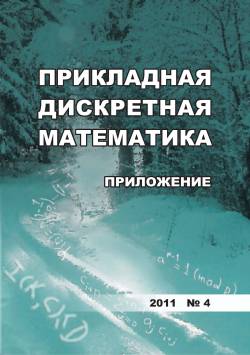SIBCiphers - symmetric iterative block ciphers composed of boolean functions depending on small number of variables
A class of symmetric iterative block ciphers called SIBCiphers is defined. Each round of a cipher in this class encrypts bitstrings of length n into bit-strings of length n according to a system of n Boolean functions each depending on k ^ n arguments taken from the bitstring on the inputs of the round and jointly representing an injective mapping. Formally, for l-th round in a r-round SIBCipher, there exist an injection : {0,1} ^ {0,1} , Boolean functions : {0,1} ^ {0,1}, and mappings : {1,2,...,k} ^ {1,2, ...,n}, i = 1,2,...,n, such that {n (j) : i = 1, 2,...,n; j = 1, 2,..., k} = {1, 2,...,n} and if u = м 1м 2 ... u n G {0,1} , then g (u) = й!^)^^)... g?(v„), where v = Ui xUi 2... Ui k and j = n (j), i = 1, 2,..., n; j = 1, 2,..., k. A round key consists of some of Boolean functions (g ) at the round and of numbers (n (j)) of their actual arguments. The ciphertext bitstring is obtained by permuting the bits on the outputs of the last (r-th) round. Contemporary symmetric iterative block ciphers with additive round keys form a subclass of SIBCiphers. Two other subclusses of SIBCiphers called by names Lucifer and Feistel are constructed according to the known cryptographic schemes originally suggested by H. Feistel and implemented in ciphers LUCIFER and DES respectively. In SIBCipher of Feistel's subclass, g (u) = L 1R 1 if u = L 0R 0 for L 0,R 0 G {0,1} , L 1 = R 0 and R 1 = p (L 0) 0 f (R 0), where p : {0,1} ^ {0,1} is a permutation = o f (1) (z) = 1 1 2 2 . . . f^C^), i = ii i2 . . . j = n for some Boolean functions f i : {0,1} ^ {0,1} and for a surjective system of mappings : {1, 2,..., k} ^ {1, 2,... , n/2}, i = 1, 2,..., n/2; j = 1, 2,... , k. SIBCipher of the subclass Lucifer is characterized by the folloving properties: (a) n = = ks, s > 1; (b) for any pair (l, i), l = 1, 2,..., r and i = 1, 2,..., s, the mapping G : {0,1} ^ {0,1} defined as (z) = gL^^^L^z).. .^(z) for all z G {0,1} , is a substitution; (c) n(i- 1) k+1 = n(i _ 1) k+2 = ... = Пг^; and (d) the mappingp : {0,1} ^ ^ {0,1} , where p (u) = p1 (u)p2 (u).. .pS°(u) and pi (u) = u^o (1)u nci)( 2). ..u v(i)^ k) for i =1, 2,..., s, is a permutation.
Keywords
криптография, булевы функции, симметричные итеративные блочные шифры, сеть Фейстеля, шифр Люцифер, cryptography, Boolean functions, symmetric iterative block ciphers, Feistel network, cipher LUCIFERAuthors
| Name | Organization | |
| Agibalov G. P. | agibalov@isc.tsu.ru |
References
